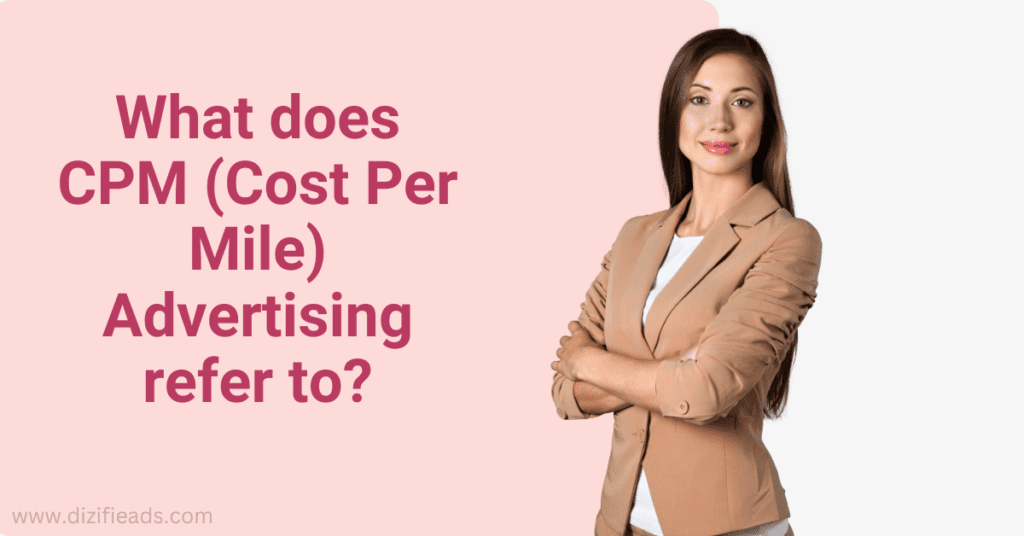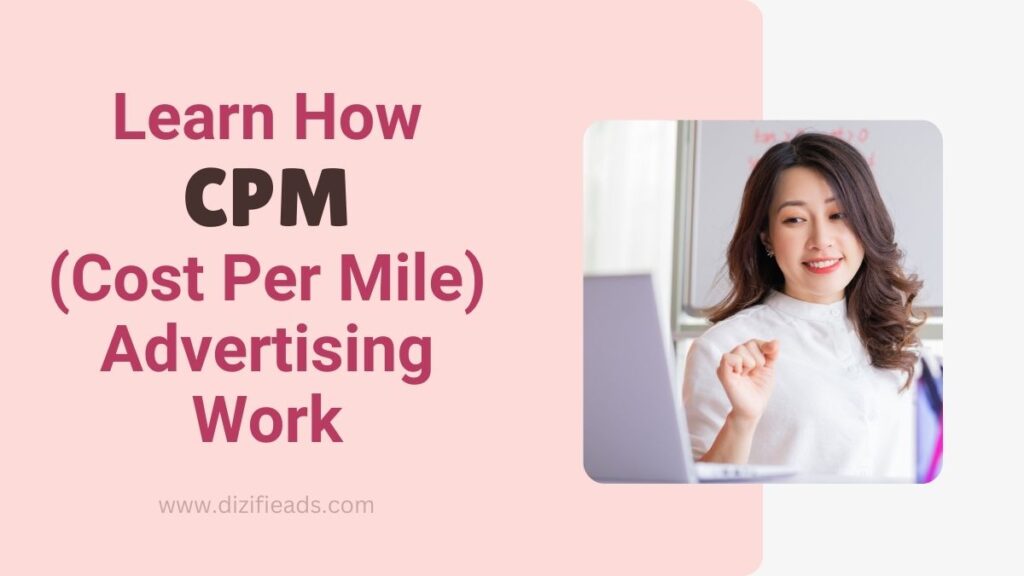CPM (Cost Per Mile) Advertising
The world of digital trade changes fast. Advertisers always look for ways to reach more people. They want to get the most from their investments. One important tool they use is CPM (Cost Per Mile) Advertising. This guide will take you through CPM. It will explain how it works, its advantages, and how to use it to meet your trade goals. Let’s see how this strategy can help you. It can aid in the digital trade topography.
What is CPM (Cost Per Mile) Advertising?

CPM promotion is short for cost per thousand impressions. Advertisers pay a fixed price for every thousand views of their ads or social media posts. Every time an ad appears on a screen, it counts as an impression. This happens even if the user doesn’t click on it. Companies use CPM for promotion. They track how often their ads are seen. They assess it with a variety of online groups. This method enables advertisers to see how well their campaigns work. It also helps them decide how to reach their ideal audiences.
How Does CPM (Cost Per Mile) Advertising Work?
In CPM promotion, which means cost per mile, advertisers are in a contest. They do this by bidding on the ad space they want and estimating the views their ads will get. They buy ad space through ad networks or from site or app owners. An auction or negotiation sets the price for 1,000 impressions. It’s between advertisers and the ad space owners.
Increased Brand Exposure:
CPM advertising is popular. This is known as the cost per thousand impressions. It allows businesses to promote their products or services. Advertisers pay for every 1,000 views of their ad online. It can reach many people and enhance their brand. When users see the ad, it helps build trust in the brand. This boosts the chances of turning viewers into loyal customers.
Cost-Efficiency:
CPM promotion is different from other pricing models. These models include CPC (Cost Per Click) or CPA (Cost Per Action). It guarantees direction to a set number of users. This makes it a cheap option for brand campaigns.
Targeted Reach:
Advertisers can target their ads to specific groups. These groups can be by demographics, interests, or behaviors. This ensures that their message reaches the most appropriate audience.
Maximizing ROI with CPM Advertising

CPM promotion offers several benefits, maximizing ROI requires careful planning and execution. Here are some strategies to help you get the most out of your CPM campaigns:
1. Make Ad Creative Better. Good ad creativity is key. It captures the audience’s attention and drives engagement. Test different ad formats, visuals, and messages. This will help you find what resonates best with your audience.
2. Refine your targeting. Use the targeting options ad platforms offer. They help you reach the best audience for your campaign. Improve your targeting. Do it based on demographics, interests, and past behavior. This will improve your ad performance.
3. Check Performance Metrics. Track key metrics like click-through rate (CTR), conversion rate, and cost per conversion. Use them to see how well your CPM campaigns work. Use this data to optimize your targeting, ad creative, and bidding strategy.
4. Adjust Bidding Strategy. Experiment with different strategies. Aim for the best mix of cost and performance. Next, tweak your bids to align with the competition for ad space. Keep in mind the worth of the audience you’re aiming for.
5. Continuous Optimization is key. You must often fine-tune your campaigns to boost the value of CPM ads. This means checking your ad’s data. Make needed changes. Hone your strategy to improve the outcomes. You can get better results by managing and improving your campaigns over time. You can increase the success of your advertising efforts.
Important FAQs About CPM (Cost Per Mile) Advertising
What exactly is CPM advertising?
CPM advertising, or cost per thousand impressions, is a pricing model where advertisers pay a fixed rate for every thousand impressions their ad receives, of click interactions.
How does CPM promotion differ from other pricing models like CPC or CPA?
CPM advertising guarantees exposure to a set number of users. Every time a displayed ad reaches a specific number of people. This type of ad is great for brand awareness campaigns. It makes sure a big audience sees the ads. This helps to create brand recognition and familiarity. In comparison, CPC and CPA models pay only for clicks on the ad or complete an action. This may not always give the same exposure or brand visibility as CPM ads.
What are your impressions of CPM promotion?
Impressions refer to the number of times an ad is shown to a user. Each time an ad is shown on a webpage, it counts as one impression.
How is the cost per thousand impressions (CPM) estimated?
To estimate the CPM, divide the total cost by the number of impressions. you breed by 1000.
Where can I buy the CPM promotion inventory?
CPM promotion inventory can be bought through ad networks, demand-side media (DSPs), or directly from publishers.
What are some benefits of CPM promotion?
The benefits of CPM advertising include increased brand exposure, cost-efficiency, targeted reach, and the ability to reach a large audience.
How can I target my CPM ads to specific audiences?
Advertisers can target their CPM ads based on demographics, interests, behaviors, geographic location, device type, and more, depending on the targeting options offered by the ad platform.
What types of ad formats are available for CPM advertising?
Common ad formats for CPM advertising include display ads, video ads, native ads, and sponsored content.
How do I know if my CPM campaign is performing well?
Key performance metrics to monitor in CPM advertising include click-through rate (CTR), conversion rate, cost per conversion, ad viewability, and return on investment (ROI).
What strategies can I use to optimize my CPM campaigns?
Strategies for optimizing CPM campaigns include optimizing ad creative, refining targeting, monitoring performance metrics, adjusting bidding strategy, and continuous optimization.
Is CPM advertising suitable for all types of businesses?
CPM advertising helps all kinds of businesses. It’s good for any industry. Helpful for those who want to raise brand awareness and reach a big audience.
What are some common pitfalls to avoid in CPM advertising?
Common pitfalls in CPM advertising include targeting too broad or too narrow audiences, neglecting ad creativity, overbidding for ad inventory, and failing to monitor performance metrics.
Can I track conversions in CPM advertising?
CPM advertising focuses on impressions, not clicks or conversions. conversion tracking tags or pixels to your website.
How can I measure the effectiveness of my CPM campaigns?
The effectiveness of CPM campaigns can be measured using key performance indicators ad engagement metrics, conversion metrics, and return on investment (ROI).
Are there any best practices for CPM advertising?
Best practices for CPM advertising include testing different ad creatives, refining targeting based on audience insights, monitoring performance metrics regularly, and optimizing campaigns based on data-driven decisions.
Conclusion
CPM advertising offers advertisers a powerful tool. It helps them reach a large audience and boost brand exposure. Advertisers can meet their goals by understanding CPM ads and using good strategies. They can maximize their ROI. Careful planning, optimization, and monitoring can make CPM ads valuable. They can enhance any digital marketing campaign.

